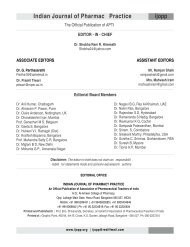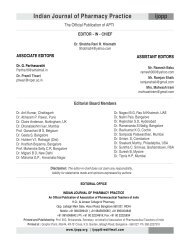APTI ijopp - Indian Journal of Pharmacy Practice
APTI ijopp - Indian Journal of Pharmacy Practice
APTI ijopp - Indian Journal of Pharmacy Practice
- No tags were found...
You also want an ePaper? Increase the reach of your titles
YUMPU automatically turns print PDFs into web optimized ePapers that Google loves.
<strong>Indian</strong> J. Pharm. Pract. 1(2), Jan-Mar, 2009Sanhita, Chakradatta and Nighandu Ratnakara which are simultaneously. Patients were encouraged to report any<strong>of</strong> use in treating this condition.adverse reaction to the physician during the course <strong>of</strong>Common herbs such as Dhataki Flower, Musta, treatment.Mocharas, Lodhra, Lata Karanja have actions that RESULTS & DISCUSSIONinclude antifungal, antimicrobial, antiseptic, astringent, 36 patients completed the preliminary clinical study withand demulcents(13). Herbs with astringent activity may the polyherbal preparation (WH1). WH1 reduced theproduce a protective coating on the tissue surface. amount <strong>of</strong> vaginal discharge significantly in all theTherapeutically, these herbs may reduce irritation, patients both symptomatically and clinically. Significantinflammation, and excessive fluid secretion, and provide results were seen microbiologically in 30 patients (83%).a barrier against infection. Antiseptic and antimicrobial During the study period, 58 patients were enrolled; onlyherbs may work to eliminate bacterial and viral 36 patients completed the study. 22 patients wereinfections, and antifungal herbs may help fight fungal therefore excluded from the study as per the protocolinfections. A list <strong>of</strong> herbs containing these qualities for design. Hence, statistics <strong>of</strong> only 36 patients whothe treatment <strong>of</strong> vaginitis is shown in Table-1.completed the trial has been presented here and theTraditionally, a mixture <strong>of</strong> powder <strong>of</strong> the herbs listed inresults were summarized as percentages. Age <strong>of</strong> patientsTable-1 in the medium <strong>of</strong> ghee as “Anupana” [vehicle <strong>of</strong>ranged between 18 and 55 years (Fig.1) which explainsadministration] has been used effectively in the treatmentincidences <strong>of</strong> risk factors such as child birth, abortions,<strong>of</strong> vaginitis. However, there has been no documentationpassage <strong>of</strong> infective organism by infected semen etc inregarding its efficacy and safety.this age group (14). Maximum patients belonged to lowHence, the objective <strong>of</strong> this work was to take up apreliminary clinical study in a small patient group toincome group. Poor hygienic conditions, ignoranceconfirm the efficacy and safety <strong>of</strong> this poly herbalabout the proper cleaning and toilet habits and badpreparation (WH1). Therefore, this mixture <strong>of</strong> powdersnutritional status explains the higher incidence <strong>of</strong> thisin ghee base was formulated as s<strong>of</strong>t gelatin capsules. The condition amongst this group (14). Duration <strong>of</strong>formula <strong>of</strong> this preparation is given in Table 2.complaints varied from less than 1 month (4 days) to 8METHODyears (Fig.2) which further confirms that women areInstitutional Ethical committee clearance was obtained busy in managing the household work without takingfrom Sri Sai Charitable Dispensary, Girinagar, Bangalore sufficient care regarding their own health. 25 patientsand Shreyas Poly Clinic & Laboratory, Chamarajpet, improved with the first course <strong>of</strong> 10 days treatmentBangalore, where the study was conducted for a period (69%). 7 patients received 2 courses <strong>of</strong> medicine and 2<strong>of</strong> six months, from November 2006 to April 2007. patients 3 courses <strong>of</strong> medicine. 2 patients received moreInformed consent was taken from all patients included inthan 4 courses <strong>of</strong> medicine without benefit (Fig.3). Thethe study after explaining to them the purpose <strong>of</strong> theetiology <strong>of</strong> patients observed by microbiologicalstudy.examination is given in (Fig.4). 17 patients wereInclusion Criteria: All patients presented withsymptoms <strong>of</strong> vaginitis at the clinic during the studydiagnosed as non specific vaginitis (47%), 14 asperiod <strong>of</strong> 6 months.Bacterial Vaginitis (39%), 3 as vaginal candidiasis (8%)Exclusion Criteria: Patients with white discharge due to and 1 each as atrophic vaginitis and senile vaginitis (3%).any other clinical condition like fibroid, malignancy etc The swabs taken after 15 days and after one month, whichand pregnant women.assessed the effectiveness <strong>of</strong> the treatmentAll patients who met the inclusion criteria were recruited microbiologically, showed 83% (30/36) patientsfor the study. These patients were clinically examined improved with treatment and no improvement was seenand a swab was taken from the vaginal discharge and sent in 17% (6/36) <strong>of</strong> patients (Fig.5). None <strong>of</strong> the patients into pathological laboratory. All patients were prescribed this series experienced any adverse reactions. Thus, thethe poly herbal formulation (WH 1) thrice a day for 10 polyherbal preparation (WH1) effectively produceddays after food. Two fortnightly follow ups were clinical and microbiological relief in women withconducted and progress was assessed by clinical vaginitis <strong>of</strong> varied etiology.improvements and confirmed by swab test. If the CONCLUSIONcondition was not improved, another course <strong>of</strong> treatment The polyherbal formulation (WH1) has shownwas repeated and the sexual partner also treated significant results in the treatment <strong>of</strong> vaginitis. But this70
















